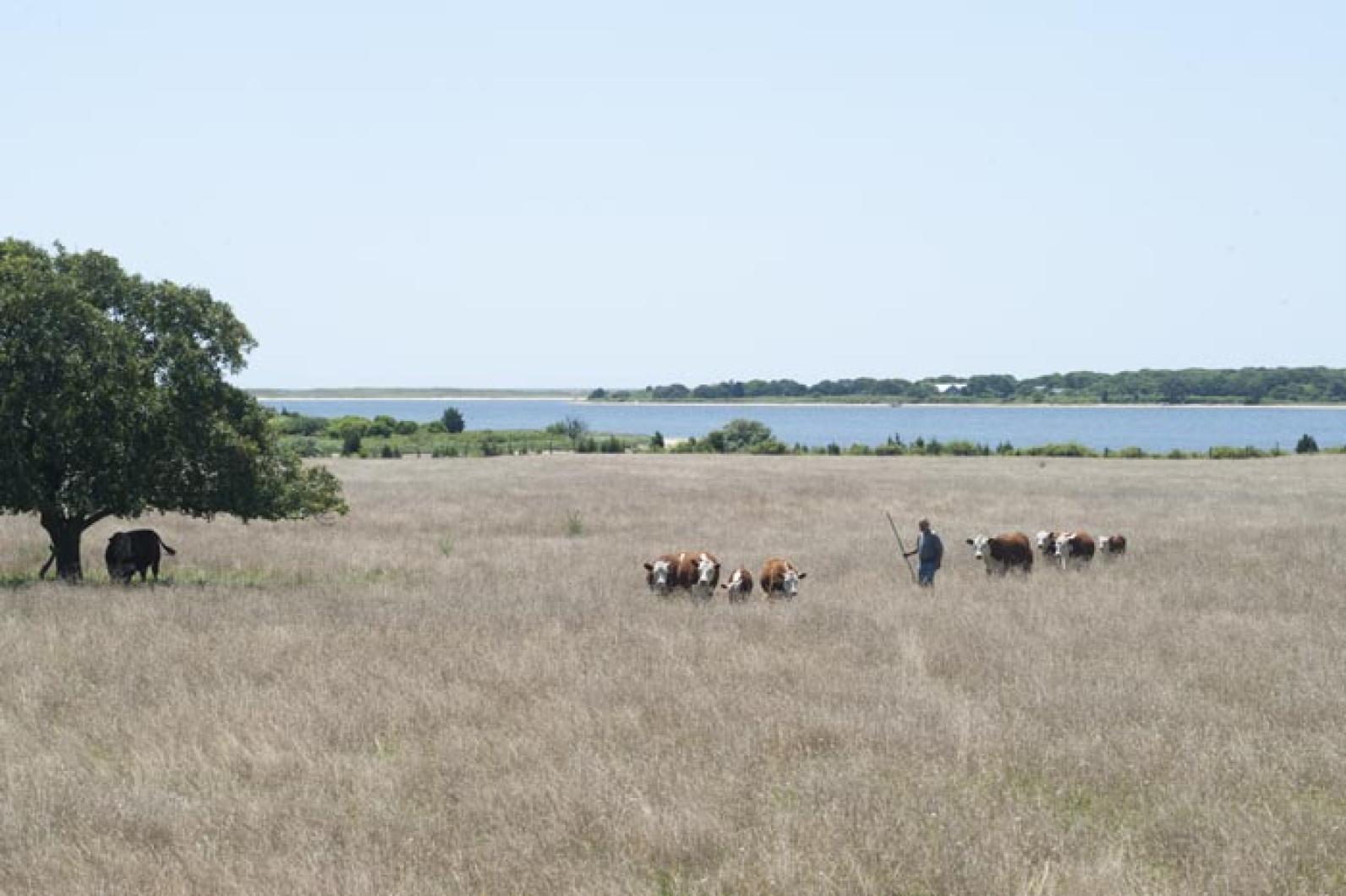Fifty years ago last month, National Geographic did a full spread on Martha’s Vineyard. There were beautiful photographs and an article written about the iconic character of the place. The June 1961 issue, edges worn, cover faded, is still tucked onto bookshelves in many old Island family homes. Copies have passed from one generation to the next as a keepsake, like an old Vineyard book.
Thirty-one pages in the magazine brought international notoriety to the Vineyard as a special place, well before the Chappaquiddick incident.
Arnie Fischer, a farmer and owner of Flat Point Farm in West Tisbury, is a living piece of that story. His family’s farm is pictured in the magazine photo essay. The photograph portrays a warm, rustic and colorful farmland. A young man with a stick leads a herd of cows across an open field, with the Tisbury Great Pond and beaches beyond. What is so striking about that picture, Mr. Fischer said recently, is that the scene still exists. The cows still are out on the field. An old oak tree with spreading branches still stands in the same spot. The open space remains pretty much as it was when the photographer clicked the camera. So Mr. Fischer had the idea of taking the picture again, 50 years later.
Mr. Fischer was five when the picture was taken and didn’t know about the National Geographic story until many years later. “I think it was my father in law, [Francis S. Duane] who showed it to me. He collected all kinds of things at yard sales. He said to me, ‘Look what I found.’ He gave me a copy.” Mr. Fischer said he was struck by the picture of his family farm featured in the article and that it still looks so familiar.
The young man in the National Geographic photograph taken by James P. Blair is Peter Houle, son of the late Ray Houle, former West Tisbury shellfish constable.
When the picture was taken, the farm was a dairy farm. Off in the distance, beyond Tisbury Great Pond, there is a large structure, a house used by the Coast Guard. “It was built with a high attic, so someone could go looking for German U-boats during World War II. Now it is a classy summer house. I remember playing poker in that house,” Mr. Fischer said. The rest of the scene is pretty much unchanged, though fence posts going across the field have shifted and the tree skyline is higher today than it was back then.
Last year, Mr. Fischer decided to try to get a copy of the original picture from National Geographic; his plan was to put it alongside a new picture of the same scene, as a way to honor the 50th anniversary of the article and the history of the farm.
But he didn’t get too far with the magazine. The photograph is owned by Getty Images, which wanted $200 to $400 for the image.
So Mr. Fischer called the Gazette to see about capturing the image again. The result is pictured here with this story.
The only significant difference between now and then is that instead of dairy cows, there are Hereford beef cattle in the picture.
The article titled Old Whaling Days Still Flavor Life on Sea Swept Martha’s Vineyard, was written by the late William P.E. Graves; his brother Ralph Graves lives in Chilmark.
The distinguished photographer Mr. Blair has photographed for Life Magazine and National Geographic. The article includes description and photographs of the Camp Ground in Oak Bluffs and scenes from Menemsha, including the Menemsha fishing boat Bozo, captained by Walter W. Manning. There are pictures from the Round the Island Race aboard the large sailboat Impala captained by James A. Farrell Jr., which back then spent each summer in Edgartown.
The Gay Head Lighthouse is different today from 50 years ago. In 1961 the lighthouse was next door to a two-family house and there was a small radar tower next door. There was also a large barn, next door, for the storage of Coast Guard lifesaving equipment. The Gay Head clay cliffs were far more colorful.
Of course most of the Island people pictured in the story are gone now: Donald Poole, a fisherman; Oscar B. Flanders, a farmer and fence viewer; Orin Norton, a blacksmith; Elden West, a shipmodel repairer; Mr. and Mrs. Henry Beetle Hough, owners of the Vineyard Gazette; Katharine Cornell, actress; and Amos Smalley, member of the Wampanoag tribe, a man who harpooned a white whale.
“I think people should dig out that old magazine and reread the article,” Mr. Fischer said. “Everyone should look at the pictures and see what the differences are between now and then. The Island is still a good place. There are still sailboats and pretty beaches. There is Ocean Park. There is farmland. I hear people say that the Vineyard is so terrible. But this is still a nice place.”




Comments (1)
Comments
Comment policy »